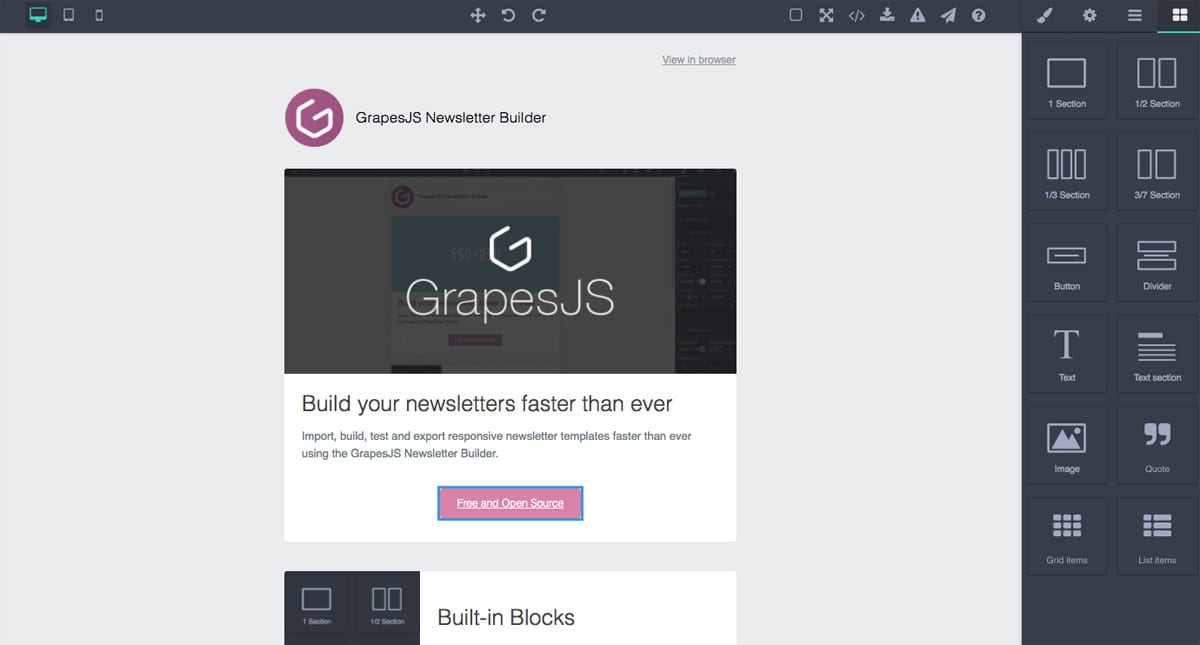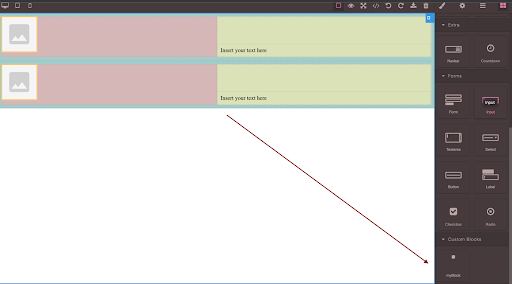开源可视化页面框架GrapesJS开发教程(四)- 创建 Block
本文是介绍可视化页面构建工具 GrapesJS开发教程系列篇之组件介绍,本系列主要是介绍GrapesJS以及与如何对接GrapesJS,如何与CMS整合等相关内容。
如果需要对GrapesJS开发还没有完全了解,可以参考我们之前的相关文章,本篇主要介绍如何在GrapesJS里面创建一个Block。

GrapesJS的组件介绍
GrapesJS 的组件是指包含有关元素在画布中如何呈现(由 View 管理)以及其最终代码,所有 Model 属性都会反映在 View 中。GrapesJS 支持添加各种自定义组件,也内置了常用的基础组件,例如区块、文本、图片等。
GrapesJS 里开发组件,首先需要弄清楚两个核心概念:Component 和 Block。
Component 定义了一个组件的标签是什么,有什么属性、方法、在Canvas里如何展示,保存为HTML时又应该是什么结果。
Block 可以理解为是一个或多个 Component 组成的“代码片段”。
通常而言,用户在组件库里看到的东西就是Block,在用户将Block拖动到Canvas里之后,Grapes JS会经由解析器将它们转换成Component,这时候用户如果要编辑组件的样式、内容、属性等,就变成和Component交互了。
GrapesJS的Block构建
GrapesJS 的Block主要由BlockManager管理,创建好Block之后,就可以进行拖拽到GrapesJS的界面中来使用和编辑。
1. 创建自定义Block
代码文件是 component.ts,主要是 ngOnInit 触发后的事件,具体代码如下:
createBlockTemplateConfirmation () {
const selected = this.editor.getSelected();
let name = this.blockTemplateForm.get('name')!.value
let blockId = 'customBlockTemplate_' + name.split(' ').join('_')
let name_blockId = {
'name': name,
'blockId': blockId
}
createBlockTemplate(this.editor, selected, name_blockId)
this.blockTemplateForm.reset();
this.modalService.getModal('createBlockTemplate').close();
}
createBlockTemplate 方法会调用相关的函数获取component的css和js内容,来看一下 createBlockTemplate的源码,(在index.ts里面)
export const getCss = (editor, id) => {
const style = editor.CssComposer.getRule(`#${id}`);
const hoverStyle = editor.CssComposer.getRule(`#${id}:hover`);
if (style){
if(hoverStyle){
return style.toCSS() + ' ' + hoverStyle.toCSS()
}
return style.toCSS()
}
else {
return ''
}
}
export const findComponentStyles = (editor:any,selected:any) => {
let css =''
if (selected){
const childModel = selected.components().models
if (childModel) {
for (const model of childModel) {
css = css + findComponentStyles(editor,model)
}
return css+ getCss(editor, selected.getId());
}
else{
return getCss(editor, selected.getId());
}
}
}
export const createBlockTemplate = (editor:any, selected:any, name_blockId:any) => {
const bm = editor.BlockManager
const blockId = name_blockId.blockId;
const name = name_blockId.name;
let elementHTML = selected.getEl().outerHTML;
let first_partHtml = elementHTML.substring(0, elementHTML.indexOf(' '));
let second_partHtml = elementHTML.substring(elementHTML.indexOf(' ') + 1);
first_partHtml += ` custom_block_template=true block_id="${blockId}" `
let finalHtml = first_partHtml + second_partHtml
const blockCss = findComponentStyles(editor,selected)
const css = ``
const elementHtmlCss = finalHtml + css
bm.add(`customBlockTemplate_${blockId}`,{
category: 'Custom Blocks',
attributes: {custom_block_template:true},
label: `${name}`,
media: '',
content: elementHtmlCss,
})
}
创建好Block之后,Block就会出现在GrapesJS的工具栏里面,然后通过拖拽就可以放到页面编辑区了,参考下图

2. 给Block添加工具菜单
在每一个Block,当鼠标划上去的时候,就会有一个工具栏,用户可以点击这个工具栏做响应的操作,当然有几个是默认的,比如复制、渲染、删除等,此外,我们也可以自定义工具,比如配置,用户点击后,就弹出一个配置框,在配置框里面,用户可以做各种操作。下面的代码就是注册一个选中事件,来触发工具条。
(我们的动态组件就是用这种方式开发的)
this.editor.on('component:selected', (editor:any) => {
// whenever a component is selected in the editor
if (!this.editor) {
this.editor = editor
}
const selectedComponent = this.editor.getSelected();
if (selectedComponent && selectedComponent.attributes) {
//createBlockTemplate functionality
const commandBlockTemplateIcon = 'fad fa-square'
const commandBlockTemplate = () => {
// this.modalService.getModal('createBlockTemplate').open(); //Commented for ………………… now as we have not made Modal yet
}
const defaultToolbar = selectedComponent.get('toolbar');
const commandExists = defaultToolbar.some((item:any) => item.command.name === 'commandBlockTemplate');
if (!commandExists) {
selectedComponent.set({
toolbar: [ ...defaultToolbar, { attributes: {class: commandBlockTemplateIcon}, command: commandBlockTemplate }]
});
}
}
});
具体的效果如下:

然后,我们给工具栏点击增加一个弹出框。
#1. 装一个modal box组件
npm i ngx-smart-modal ng add @ng-bootstrap/ng-bootstrap
#2. 在component文件里面导入表单
import {NgxSmartModalService} from 'ngx-smart-modal';
import {FormBuilder, Validators} from '@angular/forms';
下面是Component的源文件
export class CustomBlockComponent implements OnInit {
public editor:any = null
blockTemplateForm = this.formBuilder.group({
name: ['', Validators.required]
})
Component的HTML文件 :
<ngx-smart-modal #createBlockTemplate (onAnyCloseEvent)="createBlockTemplate.close()" customClass="nsm-centered" identifier="createBlockTemplate"> <div class="modal-header"> <h4 class="modal-title"> Are you sure you want to save this block template? </h4> </div> <div class="modal-body"> <div>This action cannot be undone</div> </div> <form (ngSubmit)="createBlockTemplateConfirmation()" [formGroup]="blockTemplateForm" > <!-- <app-form-errors [errors]="formErrors()"></app-form-errors> --> <div class="col-sm-12 form-group mb-3"> <label for="name">Name</label> <input id="name" type="text" class="form-control" formControlName="name"/> <!-- <app-field-errors [errors]="fieldErrors('name')"></app-field-errors> --> </div> <div class="modal-footer"> <div class="col-sm-12 form-group page-form-controls"> <button type="submit" [disabled]="!blockTemplateForm.valid" class="btn btn-primary">Save</button> <button (click)="createBlockTemplate.close()" class="btn btn-secondary" type="button">Cancel</button> </div> </div> </form> </ngx-smart-modal>
Component的CSS文件:
/* You can add global styles to this file, and also import other style files */ /* You can add global styles to this file, and also import other style files */ @import "~ngx-smart-modal/ngx-smart-modal.css"; .nsm-dialog.nsm-centered { display: grid; } .nsm-dialog-lg { max-width: 980px; } .nsm-dialog-xl { max-width: 1200px; } .nsm-dialog-xxl { max-width: 1500px; } .nsm-dialog-full { max-width: 100%; }
最终,点击工具栏,得到如下效果,

Drupal与GrapesJS的集成演示请点击这里>>
更多GrapesJS开发以及Drupal CMS相关内容,请参考我们其他相关文章,
3、开源CMS Drupal整合可视化构建工具GrapesJS(一)
4、开源可视化页面框架GrapesJS教程(二)- 组件开发
5、可视化页面框架GrapesJS开发教程(三)- 与Drupal CMS整合
6、开源可视化页面框架GrapesJS开发教程(四)- 创建 Block
7、CMS与可视化构建工具GrapesJS整合之动态组件开发(五)

 QQ交谈客服1
QQ交谈客服1

